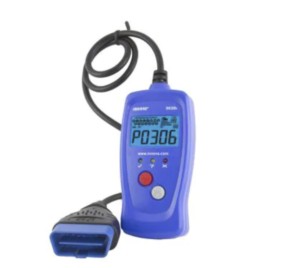The OBD-II trouble code P0128, a generic code affecting many vehicle makes and models, indicates an issue within your car’s cooling system. Specifically, it signals that your engine coolant temperature is not reaching the expected regulating temperature within a reasonable timeframe after the engine starts. This condition is detected by your vehicle’s Powertrain Control Module (PCM) by comparing readings from the engine coolant temperature sensor, intake air temperature sensor, and the duration the engine has been running.
While a genuine engine overheating issue is a possibility, the most frequent culprit behind a P0128 code is a malfunctioning thermostat. Understanding the nuances of this code, its symptoms, potential causes, and effective fixes is crucial for maintaining your vehicle’s health and performance.
Understanding the P0128 Code: Coolant Thermostat Malfunction
At its core, the P0128 code means your vehicle’s PCM has determined that the engine coolant is not warming up as quickly as it should. The PCM constantly monitors various sensors to ensure the engine operates within optimal temperature ranges. When the coolant temperature sensor reports readings that are lower than expected for a given engine run time and intake air temperature, the P0128 code is triggered, and the malfunction indicator lamp (MIL), commonly known as the check engine light, illuminates on your dashboard.
This trouble code often points to a problem with the thermostat, a critical component in your vehicle’s cooling system. The thermostat’s job is to regulate coolant flow to the engine. When the engine is cold, the thermostat remains closed, restricting coolant flow to help the engine reach its operating temperature quickly. Once the engine warms up, the thermostat opens, allowing coolant to circulate through the radiator to prevent overheating.
 OBD Readers & Scan Tools
OBD Readers & Scan Tools
Common Symptoms Associated with a P0128 Code
While a P0128 code doesn’t always lead to immediate, noticeable driving problems, it’s important to address it promptly to prevent potential long-term engine issues. Here are the most common symptoms you might experience:
- Check Engine Light (MIL): This is the most obvious symptom. The check engine light will turn on to alert you to a detected problem.
- Delayed Engine Warm-Up: You might notice your engine takes longer than usual to reach its normal operating temperature, especially in cold weather. The heat from your car’s vents might also take longer to become warm.
- Temperature Gauge Fluctuations: In some cases, you might observe the temperature gauge on your dashboard fluctuating or reading lower than normal, particularly when driving at highway speeds or in colder conditions.
- Reduced Fuel Efficiency: A consistently cooler-running engine due to a faulty thermostat can negatively impact fuel economy. The engine management system might compensate by enriching the fuel mixture, leading to increased fuel consumption.
Potential Causes of a P0128 Code
Several factors can contribute to a P0128 code. While a faulty thermostat is the most common culprit, other components within the cooling system should also be considered:
- Faulty Thermostat: A thermostat stuck in the open position is the most likely cause. When stuck open, coolant continuously circulates to the radiator, preventing the engine from reaching its optimal operating temperature quickly.
- Low Coolant Level: Insufficient coolant in the system can hinder proper temperature regulation and trigger a P0128 code. Low coolant can be due to leaks in the system.
- Faulty Engine Coolant Temperature Sensor (ECT): If the ECT sensor is malfunctioning, it might send inaccurate temperature readings to the PCM, leading to a false P0128 code.
- Faulty Intake Air Temperature Sensor (IAT): Although less common, a malfunctioning IAT sensor can also contribute to a P0128 code by providing incorrect air temperature readings to the PCM, which are used in temperature regulation calculations.
- Cooling Fan Issues: A cooling fan that is running excessively or constantly can overcool the engine, especially in colder climates, potentially triggering a P0128 code.
How to Diagnose and Fix a P0128 Code
Diagnosing and fixing a P0128 code typically involves a systematic approach, starting with the simplest and most likely causes:
-
Check Coolant Level: Begin by checking your engine coolant level. Ensure the engine is cool before opening the coolant reservoir. If the level is low, top it off with the correct type of coolant as specified in your vehicle’s owner’s manual. Inspect for any visible leaks.
-
Inspect the Thermostat: The thermostat is a prime suspect for P0128. However, visually inspecting a thermostat for faults can be difficult. In many cases, replacement is the most straightforward diagnostic step, especially if other simpler causes are ruled out. Consult your vehicle’s repair manual for the thermostat’s location and replacement procedure.
-
Evaluate Coolant Temperature Sensor (ECT) and Intake Air Temperature Sensor (IAT): If replacing the thermostat doesn’t resolve the issue, consider testing the ECT and IAT sensors. A multimeter can be used to check their resistance values, comparing them to specifications in your repair manual. Sensor replacement might be necessary if they are found to be faulty.
-
Examine the Cooling Fan: Check if the cooling fan is running excessively or constantly, even when the engine is cold. If so, there might be an issue with the fan control system that needs further investigation.
If you are not comfortable performing these diagnostic and repair steps yourself, it’s always recommended to seek assistance from a qualified mechanic. They have the expertise and tools to accurately diagnose the root cause of the P0128 code and perform the necessary repairs to restore your vehicle’s cooling system to proper working order. Addressing a P0128 code promptly ensures optimal engine performance, fuel efficiency, and prevents potential engine damage from improper temperature regulation.
